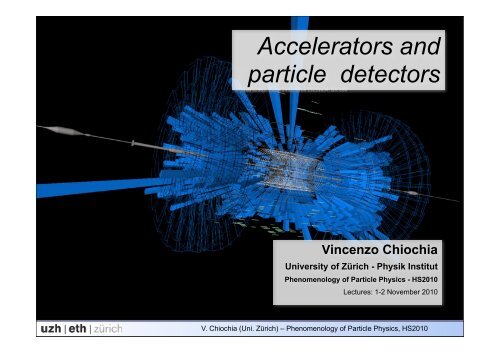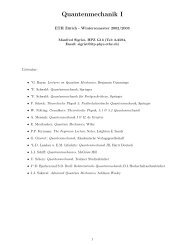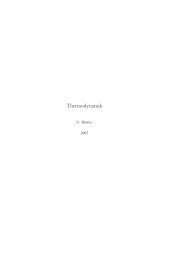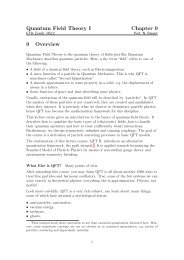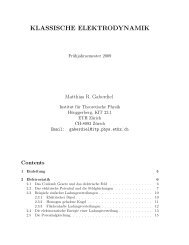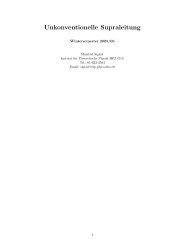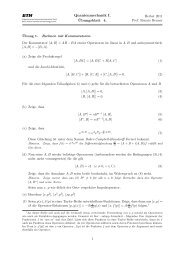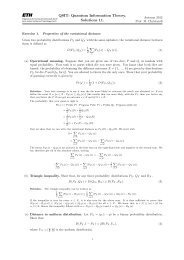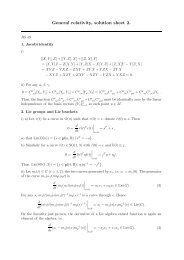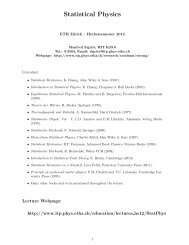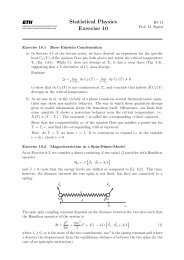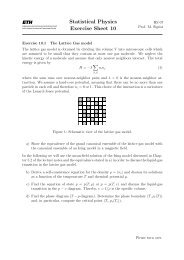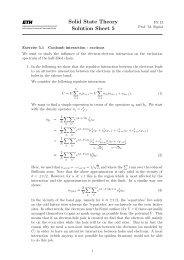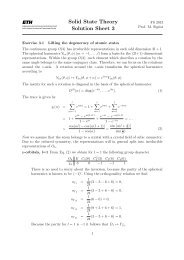Accelerators and particle detectors - Institute for Theoretical Physics
Accelerators and particle detectors - Institute for Theoretical Physics
Accelerators and particle detectors - Institute for Theoretical Physics
Sie wollen auch ein ePaper? Erhöhen Sie die Reichweite Ihrer Titel.
YUMPU macht aus Druck-PDFs automatisch weboptimierte ePaper, die Google liebt.
<strong>Accelerators</strong> <strong>and</strong><br />
<strong>particle</strong> <strong>detectors</strong><br />
Vincenzo Chiochia<br />
University of Zürich - Physik Institut<br />
Phenomenology of Particle <strong>Physics</strong> - HS2010<br />
Lectures: 1-2 November 2010<br />
V. Chiochia (Uni. Zürich) – Phenomenology of Particle <strong>Physics</strong>, HS2010
Lectures outlook<br />
Introduction to <strong>particle</strong> accelerators <strong>and</strong> <strong>detectors</strong><br />
Basic principles of <strong>particle</strong> accelerators<br />
Fixed target <strong>and</strong> collider experiments<br />
Center of mass energy<br />
Luminosity, Cross section, Event rates<br />
Basic building blocks of a <strong>particle</strong> physics experiment<br />
Momentum measurement<br />
Data analysis tools <strong>and</strong> kinematics:<br />
Rapidity<br />
Momentum conservation:<br />
• Transverse momentum, missing momentum<br />
Invariant mass<br />
V. Chiochia (Uni. Zürich) – Phenomenology of Particle <strong>Physics</strong>, HS2010<br />
2
Introduction<br />
Modern techniques in experimental <strong>particle</strong> physics can be divided into:<br />
Non accelerator-based experiments<br />
• Examples: Cosmic rays, solar <strong>and</strong> atmospheric neutrinos, searches <strong>for</strong> dark matter<br />
Accelerator-based experiments<br />
• Example: fixed target experiments, <strong>particle</strong> colliders<br />
V. Chiochia (Uni. Zürich) – Phenomenology of Particle <strong>Physics</strong>, HS2010<br />
3
Particle accelerators: motivations<br />
Fundamental tool <strong>for</strong> research in physics<br />
Main parameter is the beam energy:<br />
More energy → Shorter wavelength<br />
• Can investigate structures with size λ=h/p.<br />
More energy → Can produce new <strong>particle</strong>s<br />
Accelerate beam of stable <strong>particle</strong>s (e.g. protons, anti-protons, e + , e - )<br />
Applications of a <strong>particle</strong> accelerator:<br />
Collide with other beams <strong>and</strong> study resulting interactions<br />
Collide against a fixed target<br />
• Study resulting interactions<br />
• Produce a secondary beam of <strong>particle</strong>s (stable, unstable, charged, neutral) <strong>for</strong> a<br />
subsequent collision<br />
V. Chiochia (Uni. Zürich) – Phenomenology of Particle <strong>Physics</strong>, HS2010<br />
4
Particle accelerators: motivations<br />
Search <strong>for</strong> new sub-structures:<br />
De-Broglie equation: λ=h/p. Increases resolving power at higher energies.<br />
p=1 GeV/c → λ=1.24·10 -15 m<br />
p=10 3 GeV/c → λ=1.24·10 -18 m<br />
Search <strong>for</strong> new <strong>particle</strong>s with high mass:<br />
Example: collision in the laboratory frame between two <strong>particle</strong>s: (m1,p1) <strong>and</strong><br />
(m2,p2)<br />
Production energy threshold is: Ecm=Σimic 2 , Ekin=0<br />
Ecm grows with EL → can produce higher masses<br />
Summary: can produce <strong>particle</strong>s not contained in ordinary matter<br />
V. Chiochia (Uni. Zürich) – Phenomenology of Particle <strong>Physics</strong>, HS2010<br />
5
Example: Inelastic proton collisions<br />
We want to produce 3 protons <strong>and</strong> 1 antiproton colliding a proton<br />
beam agains a proton target (pp→pppp)<br />
What is the minimum momentum of the proton beam?<br />
Solution:<br />
m1 = m2 = 0.9383 Gev/c 2<br />
m(anti-proton) = m(proton)<br />
pL=p1, p2=0<br />
At threshold: ECM = 4m = 3.7532 GeV<br />
Solving in p1: p1=6.5 GeV/c<br />
V. Chiochia (Uni. Zürich) – Phenomenology of Particle <strong>Physics</strong>, HS2010<br />
6
Center of mass energy<br />
As we have seen, ECM is the energy available to generate mass<br />
In a beam-target collision ECM grows slowly with the beam energy<br />
large<br />
V. Chiochia (Uni. Zürich) – Phenomenology of Particle <strong>Physics</strong>, HS2010<br />
7
Center of mass energy<br />
In beam-beam collisions: ECM=2xEbeam<br />
Examples:<br />
22 GeV + 22 GeV has the same ECM as 1 TeV+mtarget<br />
1 TeV + 1 TeV has the same ECM as 10 6 TeV+mtarget<br />
Much more efficient to use two beams in opposite directions<br />
The concept naturally leads to the large circular accelerators<br />
Problem:<br />
Particle density in a beam is much lower than solid or liquid target<br />
Solutions:<br />
Cross beam many times<br />
Maximize beam intensity (number of <strong>particle</strong> bunches per beam)<br />
Constraints:<br />
Works only with stable (anti)<strong>particle</strong>s (protons,electrons)<br />
High vacuum needed to avoid beam-gas interactions: ~10 -9 Pa<br />
<strong>particle</strong>-<strong>particle</strong> → circulate in two separate beam lines<br />
<strong>particle</strong>-anti<strong>particle</strong> → circulate in the same beam line, opposite directions<br />
V. Chiochia (Uni. Zürich) – Phenomenology of Particle <strong>Physics</strong>, HS2010<br />
8
Acceleration methods<br />
Can we use an electrostatic field?<br />
F=qE → Energy transfer to a charged <strong>particle</strong> → Acceleration<br />
Electrostatic field generated by potential difference (in Volts)<br />
Maximal difference ~10 MV → Maximal energy ~ 10 MeV<br />
But: Electrostatic field is conservative (i.e. line integral is zero)!<br />
Cannot be used more than one time. Total energy transferred to the beam is null!<br />
How about a variable electric field?<br />
Main idea: utilize several times a small but variable potential difference<br />
Two possibilities: circular machines <strong>and</strong> linear machines (LINACs)<br />
CIRCULAR ACCELERATOR:<br />
At least one accelerating cavity<br />
Particles receive a ΔEnergy<br />
at every turn.<br />
LINAC: multiple cavities<br />
Particles must be in phase<br />
with accelerating potential<br />
Need magnetic field to<br />
keep the beam on circular path<br />
V. Chiochia (Uni. Zürich) – Phenomenology of Particle <strong>Physics</strong>, HS2010<br />
9
Particle accelerators: some history<br />
1921: “Kaskadengenerator” (Greinacher)<br />
1924-1928: Concept <strong>and</strong> first prototype of linear accelerator (Ising, Wideröe)<br />
1932: First nuclear reaction induced by cascade <strong>particle</strong> accelerator, p 7 Li→2α<br />
with 400 keV protons (Cockroft/Walton)<br />
1930: First Van de Graaff accelerator with 1.5 MV<br />
1930-1932: First 1.5 MeV cyclotron (concept: Lawrence)<br />
Upgraded cyclotrons (Synchrocyclotron): 300-700 MeV<br />
1953: First synchrotron at Brookhaven lab - Cosmotron (concept: Oliphant/<br />
Veksler/McMillan): 3 GeV<br />
1958: Proton Syncrotron (CERN): 28 GeV<br />
1983: Tevatron (Fermilab): 1000 GeV<br />
1990: HERA (DESY): first <strong>and</strong> only electron-proton collider<br />
2008: Large Hadron Collider (CERN): up to 7000 GeV<br />
V. Chiochia (Uni. Zürich) – Phenomenology of Particle <strong>Physics</strong>, HS2010<br />
10
Abbildung 81: Prinzip des Zyklotrons.<br />
Feld emittiert werden. Ionen, die leicht nach oben oder nach unten fliegen, treff<br />
Magnetjoch. Weil aber das B-Feld nach aussen abklingt, führt die kleine vertikale<br />
Abbildung 81: Prinzip des Zyklotrons.<br />
<strong>Accelerators</strong>:<br />
ponente<br />
Cyclotron<br />
der Lorentzkraft K die Ionen in die Sollebene zurück Abbildung (Abb. 81: 82). Prinzip In der des ver Zy<br />
Richtung in einer führen Zelle alsomit die Ionen einemeine Glühdraht harmonische ionisiert. Schwingung Die Ionen durch. (Ladung Die Bedingu q) wer<br />
diese vertikale zwei “Dees” Fokussierung (D) beschleunigt lautet und führen eine spiralförmige Bahn in eine<br />
in einer Zelle mit einem Glühdraht ionisiert. Die Ionen (Ladung q) werden zwischen<br />
Magnetfeld B aus. Die Zentripetalkraft beim Radius ρ ist gleich der Lore<br />
zwei “Dees” (D) beschleunigt Centripetal inund einer führen <strong>for</strong>ce Zelle eine <strong>and</strong> mit spiralförmige einem Lorentz Glühdraht Bahn <strong>for</strong>ce in einem ionisiert. homogenen Die<br />
Magnetfeld Einheiten): B aus. Die are Zentripetalkraft balanced: zwei n “Dees” = −beim r ∂B<br />
Radius z<br />
(D) beschleunigt ρ ist gleich und derführen Lorentzkraft eine spira (S.I.<br />
Einheiten):<br />
B ∂r > 0,<br />
Magnetfeld maus. v2 Die Zentripetalkraft beim Radiu<br />
Einheiten): m v2<br />
= qvB.<br />
ρ = qvB.<br />
wobei n der Feldindex ist. Man kann zeigen, dass das Feld aber nicht zu schne (340<br />
ρ<br />
aussenMit abklingen v = ωρdarf, findet damit man die Impuls- Ionen, die also nicht Radius-unabhängige exakt entlang der<br />
Mit v = ωρ findet man Cyclotron die Impuls-frequency:<br />
also Radius-unabhängige Kreisfrequenz m<br />
Kreisfrequen<br />
Spirale v2<br />
(Zyklotron<br />
ρ = qvB. in de<br />
zontalen frequenz) Ebene fliegen, auf die Sollbahn zurückfokussiert werden. Die Bedingung<br />
frequenz)<br />
Ein Zyklotron mit exakt homogenem B-Feld liefert nur eine verschwindend kleine<br />
Mit v = ωρ<br />
ω =<br />
findet qB ω . man = qB Intensität, da es nur diejenigen Ionen beschleunigt, die in die Sollebene senkrecht zum<br />
die . Impuls- also Radius-unab<br />
Feld emittiert werden. Ionen, die leicht nach oben oder nach unten fliegen, treffen das<br />
0
Cyclotrons<br />
First successful<br />
cyclotron<br />
(Lawrence, 1931)<br />
590 MeV cyclotron at the<br />
Paul Scherrer Institut<br />
V. Chiochia (Uni. Zürich) – Phenomenology of Particle <strong>Physics</strong>, HS2010<br />
12
S<br />
ρ = , grossen Ablenkmagneten. Aus wirtschaftlichen (345) Gründen werden diese schwach fokussierenden<br />
Zyklotronen nicht mehr hergestellt und sind auch nicht mehr im Betrieb. In einem<br />
qB<br />
sodass für hohe Impulse der Durchmesser des Magnets starkunrealistisch fokussierenden gross Synchrotron wird. Hochenergie-Ringbeschleuniger<br />
sind deshalb Synchrotronen kale (Abb. Fokussierung 85) mit festem durch Dipolmagnete Radius. In mit stark inhomogenen Feldern, alternierend mit<br />
(Courant, 1952) werden die horizontale und die verti-<br />
<strong>Accelerators</strong>: Synchrotron<br />
diesen Beschleunigern wächst das B-Feld zeitlich, bis n das S1 maximale und n Feld 0, erreicht gewährleistet wird. (z.B. SAGS in Brookhaven, NPS am CERN). Somit<br />
Diese Maschinen sind makroskopisch gepulst und beschleunigen bleiben die Betatronamplituden Teilchenbündel mitund Perioden<br />
bis zu einigen Sekunden (z.B. 14 s am(a)<br />
400 GeV-SPS chrotronen vomsind CERN). Hybridmaschinen, Der Strahl wirdbei denen (b) die Ablenkung durch Dipolmagnete und<br />
damit die Magnetdimensionen klein. Moderne Syn-<br />
aus der Maschine mit einem gepulsten Kicker-Magnet dieextrahiert.<br />
Fokussierung durch magnetische Linsen (Abb. 86) erzeugt wird.<br />
rden vor allem in der Medizin zur Beschleunigung von Elektronen<br />
(a)<br />
Dipole = Bending<br />
Abbildung 86:<br />
LINAC<br />
a) Dipolmagnet zur Ablenkung der Ionen; b) Quadrupollinse zur Fokussierung der Ionen.<br />
Magnet<br />
S<br />
S N<br />
Aus vertikale Glg. (345) Fokussierungen. lässt sich eine praktische Formel herleiten. Will man den Impuls in eV<br />
Extraktion<br />
errechnen, dann dividiert man cp [J] durch die Elementarladung e (in C) (da 1 eV = 1.6×<br />
Abbildung Abbildung 85: Prinzip des Synchrotrons.<br />
10 −19 J). 84: Man Prinzip Ausfindet Glg. des (345) Betatrons. dann mit lässtq sich = ez: eine praktische (a) Formel Quadrupole herleiten. (b) Will =Focusing man den Impuls in eV<br />
errechnen, dann dividiert man cp [J] durch die Elementarladung e (in C) (da 1 eV = 1.6×<br />
Damit der Strahl horizontal und vertikal fokussiert Abbildung wird, muss 86: a) Glg. Dipolmagnet (343) erfüllt zur Ablenkung sein. der Ionen; b) Quadrupollinse zur Fokussierung der Ionen.<br />
Die Dimension Momentum, 10 Strahlumhüllenden −19 J). Mancp B variiert findet [eV] field entlang dann = <strong>and</strong> Bemerken czBρ der mit radius Sie, Sollbahn. q dass =3× = eine are ez: Die magnetische 10 Amplituden related 8 m Linse · sden −1 by: Strahl zB z.B. [T]ρ horizontal [m], defokussiert und gleichzeitig vertikal<br />
puls wächst der Radius des Beschleunigers, denn nach Glg. (340)<br />
(346)<br />
(b)<br />
Bemerken Sie, dass eine magnetische Linse den Strahl z.B. horizontal defokussiert und gleichzeitig vertikal<br />
N<br />
N S<br />
fokussiert. Abbildung Zwei aufein<strong>and</strong>er 86: a) Dipolmagnet folgende Linsen zur Ablenkung mit umgekehrten der Ionen; Polaritäten b) Quadrupollinse erzeugenzur dann Fokussierung horizontaleder undIonen.<br />
vertikale Fokussierungen.<br />
HF<br />
Bemerken Sie, dass eine magnetische Linse den Strahl z.B. horizontal defokussiert und gleichzeitig vertikal<br />
fokussiert. Zwei aufein<strong>and</strong>er folgende Linsen mit umgekehrten Polaritäten erzeugen dann horizontale und<br />
(Betatronamplituden) und damit die Dimensionen der fokussiert. Vakuumkammer Zwei aufein<strong>and</strong>er können folgende sehr gross Linsen mit umgekehrten Polaritäten erzeugen dann horizontale und<br />
vertikale Fokussierungen.<br />
110 oder<br />
cp [eV] = czBρ =3× 10 8 m · s −1 zB [T]ρ [m], (346)<br />
ρ =<br />
p<br />
Aus Glg. (345) lässt sich eine praktische Formel herleiten. Will man den Impuls in eV<br />
qB , p<br />
errechnen,<br />
[GeV/c]<br />
dann= dividiert<br />
0.3<br />
man<br />
zB[T] (345)<br />
cp [J] durch<br />
ρ[m]<br />
die Elementarladung<br />
.<br />
e (in C) (da 1 eV =<br />
(347)<br />
1.6×<br />
oder<br />
10 −19 J). Man findet dann mit q = ez:<br />
se der Durchmesser Mit Eisenmagneten Example: des Magnets Large erreicht Hadron unrealistisch manCollider:<br />
Felder p [GeV/c] gross von = typisch wird. 0.3 zB[T] Hochiger<br />
sind1 deshalb GeV/c-Protonen Synchrotronen (z =1) (Abb. ist dann 85) 2.2 mit m. festem Supraleitende Radius. InMagnete für das LHC (Large<br />
1.5 T. ρ[m] Der . Krümmungsradius für (347)<br />
cp [eV] = czBρ =3× 10 8 m · s −1 zB [T]ρ [m], (346)<br />
Mit Circumference: Eisenmagneten erreicht 27 Km man → Radius Felder von = 4.3 typisch Km 1.5 T. Der Krümmungsradius für<br />
wächst Hadron das B-Feld oder<br />
1<br />
Collider) zeitlich,<br />
GeV/c-Protonen<br />
am bis CERN das<br />
(z<br />
erreichen maximale<br />
=1) ist dann<br />
Felder erreicht<br />
2.2<br />
von<br />
m.<br />
9<br />
p [GeV/c] Supraleitende<br />
T. wird. Mit einem<br />
= 0.3 zB[T] Magnete<br />
Umfang<br />
ρ[m] . für<br />
der<br />
das<br />
Maschine<br />
LHC (347) (Large<br />
makroskopisch von 27 gepulst km<br />
Hadron<br />
und Average und<br />
Collider)<br />
einem beschleunigen magnetic mittlerenfield am CERN<br />
Feld Teilchenbündel =<br />
Mit Eisenmagneten erreichen<br />
auf 5.4 der Tesla<br />
erreicht Felder<br />
Teilchenbahn mit Peekunden<br />
erreichbare (z.B. 14<br />
man Felder von 9vonT. typisch Mit<br />
von<br />
1.5 einem<br />
5.4 T<br />
T. DerUmfang ist der maximal<br />
Krümmungsradius der Maschine für<br />
von<br />
s am Impuls Momentum<br />
27<br />
400<br />
km<br />
GeV-SPS 7und TeV/c einem<br />
= 7 für 1vom TeV/c<br />
GeV/c-Protonen mittleren Protonen. CERN). <strong>for</strong> protons<br />
Feld (z<br />
Der<br />
=1) auf ist<br />
Strahl<br />
der dann 2.2 Teilchenbahn<br />
wird<br />
m. Supraleitendevon Magnete 5.4für Tdas ist LHC der (Large maximal<br />
inem gepulsten Bei gekrümmten Hadron Collider) am CERN erreichen Felder von 9 T. Mit einem Umfang der Maschine<br />
erreichbare Kicker-Magnet Impuls Trajektorien extrahiert. 7 TeV/ctritt für Protonen. Synchrotronstrahlung auf, die zu Energieverlust<br />
von 27 km und einem mittleren Feld auf der Teilchenbahn von 5.4 T ist der maximal<br />
führt. Aus der Beiklassischen gekrümmtenTheorie Trajektorien erreichbare<br />
des<br />
Impuls<br />
Elektromagnetismus tritt 7 TeV/c Synchrotronstrahlung für Protonen.<br />
findet man auf, [36] die den zu Energieverlust<br />
Energieverlust<br />
pro Bei gekrümmten V. Chiochia Trajektorien (Uni. Zürich) tritt Synchrotronstrahlung – Phenomenology of auf, Particle die zu Energieverlust<br />
LINAC<br />
führt. Umlauf Aus der klassischen Theorie des Elektromagnetismus findet man [36]<br />
<strong>Physics</strong>,<br />
den<br />
HS2010<br />
Energieverlust<br />
pro Umlauf verlust pro ∆E Umlauf ∝ 1 E 4<br />
= 1 ρ m 4 ρ γ4 .<br />
Magnet führt. Aus der klassischen Theorie des Elektromagnetismus findet man [36] den Energie-<br />
(348)<br />
S<br />
N<br />
13
Synchrotron: main concepts<br />
Beams are injected at low energy with B field at its minimal value <strong>and</strong><br />
<strong>particle</strong>s move in a vacuum pipe<br />
At every turn the momentum grows:<br />
To keep the beam on the same radius the B field has to grow accordingly<br />
The revolution period also changes if the velocity grows<br />
The potential difference (radio-frequency) must be kept in phase with the<br />
<strong>particle</strong>s<br />
When the maximum momentum is reached the radio-frequency is switched<br />
off, then:<br />
The beam can be extracted <strong>for</strong> experimental areas or to be injected in larger<br />
synchrotrons<br />
The beams can be steered to meet in the collision points<br />
V. Chiochia (Uni. Zürich) – Phenomenology of Particle <strong>Physics</strong>, HS2010<br />
14
Synchrotron: a sketch<br />
Dipole magnets<br />
RF cavities<br />
LINAC<br />
Control room<br />
Experiment<br />
Extraction line<br />
Protection shielding<br />
V. Chiochia (Uni. Zürich) – Phenomenology of Particle <strong>Physics</strong>, HS2010<br />
15
Accelerator complexes at CERN<br />
Abbildung 87: p-Beschleuniger-Komplex am CERN. Die ISR-Maschine und LEAR wurden 1983 bzw.<br />
1997 abgestellt.<br />
The 450 GeV SPS beam is injected in the Large Hadron Collider<br />
V. Chiochia (Uni. Zürich) – Phenomenology of Particle <strong>Physics</strong>, HS2010<br />
nach vorne emittiert und sie werden in einem Ring (AA in Abb. 87) gespeichert. Die Di-<br />
16
Swiss light source<br />
Location: Paul Scherrer Institut<br />
2.8 GeV electron synchrotron<br />
288 m circumference<br />
36 dipoles, 1.4 T field<br />
177 quadrupoles<br />
100 MeV linear injector<br />
V. Chiochia (Uni. Zürich) – Phenomenology of Particle <strong>Physics</strong>, HS2010<br />
17
Reminder: cross section<br />
Measured in cm 2 . The common unit is:<br />
barn = 10 -24 cm 2<br />
[b]<br />
In the <strong>for</strong>mulas used until now, we have used the total cross section (s)<br />
The total cross section is the sum of many final states<br />
sTOT = Σi si<br />
V. Chiochia (Uni. Zürich) – Phenomenology of Particle <strong>Physics</strong>, HS2010<br />
18
Cross-sections: p-p<br />
Cross section (mb)<br />
!<br />
pp<br />
total<br />
LHC<br />
(CERN)<br />
10 2 10 -1 1 10 10 2 10 3 10 4 10 5 10 6 10 7 10 8<br />
10<br />
elastic<br />
P lab<br />
GeV/c<br />
!s GeV<br />
1.9 2 10 10 2 10 3 10 4<br />
Source: http://pdg.lbl.gov/2006/hadronic-xsections/hadron.html<br />
V. Chiochia (Uni. Zürich) – Phenomenology of Particle <strong>Physics</strong>, HS2010<br />
19<br />
)
10<br />
elastic<br />
Cross sections: p-antip<br />
P lab<br />
GeV/c<br />
10 -1 1 10 10 2 10 3 10 4 10 5 10 6 10 7 10 8<br />
!s GeV<br />
1.9 2 10 10 2 10 3 10 4<br />
TEVATRON<br />
(FERMILAB)<br />
Cross section (mb)<br />
!<br />
p− p<br />
total<br />
10 2 10 -1 1 10 10 2 10 3 10 4 10 5 10 6 10 7 10 8<br />
10<br />
elastic<br />
P lab<br />
GeV/c<br />
Figure 40.11: Total <strong>and</strong> elastic cross sections <strong>for</strong> pp <strong>and</strong> pp Source: collisions http://pdg.lbl.gov/2006/hadronic-xsections/hadron.html<br />
as a function of laboratory beam momentum<br />
<strong>and</strong> total center-of-mass energy. Corresponding computer-readable data files may be found at<br />
V. Chiochia (Uni. Zürich) – Phenomenology of Particle <strong>Physics</strong>, HS2010 20<br />
http://pdg.lbl.gov/xsect/contents.html (Courtesy of the COMPAS group, IHEP, Protvino, August 2005)
Luminosity<br />
Cross section = s<br />
Number of events per second = rate = R<br />
R = L s<br />
L=Luminosity. Characterizes accelerator per<strong>for</strong>mances in [cm -2 s -1 ]<br />
Example:<br />
Consider a e+e- accelerator with N <strong>particle</strong>s per beam turning f times per sec.<br />
Gaussian shaped beam with dimensions sx <strong>and</strong> sy → transverse size = 4psxsy<br />
One electron in one turn crosses N/(4psxsz) positrons<br />
Number of collisions per second<br />
fN 2<br />
4psxsy<br />
Number of events per second<br />
R=<br />
sfN 2<br />
4psxsy<br />
V. Chiochia (Uni. Zürich) – Phenomenology of Particle <strong>Physics</strong>, HS2010<br />
21
Instantaneous luminosity: LHC<br />
2x10 32 cm -2 s -1<br />
Accelerator luminosity is gradually increased by increasing the number of<br />
<strong>particle</strong>s in the beam <strong>and</strong> squeezing the beam size at the intersection point<br />
Note: final target instantaneous luminosity <strong>for</strong> LHC is 10 34 cm -2 s -1<br />
V. Chiochia (Uni. Zürich) – Phenomenology of Particle <strong>Physics</strong>, HS2010 22
Integrated luminosity<br />
The integral of the delivered luminosity over time is called integrated luminosity<br />
The integrated luminosity is a measurement of the collected data size<br />
Example:<br />
Integrated luminosity<br />
from the LHC<br />
(March-November 2010)<br />
V. Chiochia (Uni. Zürich) – Phenomenology of Particle <strong>Physics</strong>, HS2010<br />
23
Luminosity: example<br />
Electron-Positron Accelerator ring:<br />
Ring is 100m long <strong>and</strong> revolution frequency is f=3·10 6 Hz<br />
N=10 10 <strong>particle</strong>s, sx=0.1 cm, sy=0.01 cm<br />
L = 0.2x10 29 cm -2 s -1<br />
We are interested in a rare process:<br />
Example e + e - →pp <strong>and</strong> ECM~2-3 GeV<br />
Cross section: s = 1nb = 10 -33 cm 2<br />
R=10 -4 events per second<br />
~0.35 events/hour<br />
~8.5 events/day<br />
V. Chiochia (Uni. Zürich) – Phenomenology of Particle <strong>Physics</strong>, HS2010<br />
24
Particle physics experiments<br />
Particle <strong>detectors</strong> are disposed around the interaction region <strong>and</strong><br />
detect (directly or indirectly) the reaction products<br />
Typical measurements per<strong>for</strong>med:<br />
Spatial coordinates <strong>and</strong> timing of final state <strong>particle</strong><br />
Momentum: Px, Py, Pz<br />
Energy<br />
Type of <strong>particle</strong> (<strong>particle</strong> ID): pion, Kaon, proton, muon, etc.<br />
V. Chiochia (Uni. Zürich) – Phenomenology of Particle <strong>Physics</strong>, HS2010<br />
25
Momentum measurement<br />
In high energy experiments the<br />
momentum measurement is based on the<br />
deflection of charged <strong>particle</strong>s in a<br />
magnetic field<br />
Simple case:<br />
Dipole magnet<br />
Measure track direction be<strong>for</strong>e <strong>and</strong> after<br />
magnet<br />
In collider experiment:<br />
B field parallel to beams<br />
Curvature only in the transverse plane<br />
Momentum resolution:<br />
length<br />
θ<br />
R<br />
⊗B<br />
|p| = 0.3 |B| R<br />
length = l = 2 R sin (θ/2) ~ R θ<br />
θ = length/R = 0.3 B l / p<br />
p = 0.3 B l / θ<br />
σ(pT)<br />
pT<br />
σrϕ pT<br />
= 0.3 B l R 2 [720/(n+4)]-1/2<br />
σrϕ = error on each measurement point<br />
lR = radial length of the track<br />
n = number of equidistant points<br />
⊗<br />
B<br />
R<br />
ϕ<br />
V. Chiochia (Uni. Zürich) – Phenomenology of Particle <strong>Physics</strong>, HS2010<br />
26
Fixed target experiments<br />
For fixed target experiments the production is essentially in the<br />
<strong>for</strong>ward direction<br />
Beam<br />
Target<br />
Detector<br />
V. Chiochia (Uni. Zürich) – Phenomenology of Particle <strong>Physics</strong>, HS2010<br />
27
Example: FOCUS experiment<br />
V. Chiochia (Uni. Zürich) – Phenomenology of Particle <strong>Physics</strong>, HS2010<br />
28
Collider experiments<br />
Cylindrical symmetry<br />
Ermeticity: measure as many of the final state <strong>particle</strong>s as possible<br />
Magnetic field (solenoidal, B parallel to the colliding beams)<br />
BARREL<br />
ENDCAP<br />
Muon identification<br />
Solenoidal magnet<br />
Muon<br />
ID<br />
Energy<br />
Energy measurement<br />
(Calorimeters)<br />
Energy<br />
Muon<br />
ID<br />
Momentum measurement<br />
(Tracking <strong>detectors</strong>)<br />
beam vacuum pipe<br />
B field<br />
Basic building blocks of a <strong>particle</strong> collider experiment<br />
V. Chiochia (Uni. Zürich) – Phenomenology of Particle <strong>Physics</strong>, HS2010<br />
29
Example: CMS Experiment<br />
Silicon strip tracker<br />
Calorimeter<br />
Muon identification<br />
Silicon pixel tracker<br />
4 Tesla solenoid<br />
V. Chiochia (Uni. Zürich) – Phenomenology of Particle <strong>Physics</strong>, HS2010<br />
30
CMS: open configuration<br />
V. Chiochia (Uni. Zürich) – Phenomenology of Particle <strong>Physics</strong>, HS2010<br />
31
CMS: closed configuration<br />
V. Chiochia (Uni. Zürich) – Phenomenology of Particle <strong>Physics</strong>, HS2010<br />
32
References<br />
1. C.Amsler, Kern- und Teilchenphysik, UTB, 2007 (www.utb.de)<br />
2. C.Grupen, B.Shwartz, Particle Detectors, Cambridge Univ. Press. 2008<br />
V. Chiochia (Uni. Zürich) – Phenomenology of Particle <strong>Physics</strong>, HS2010<br />
33


